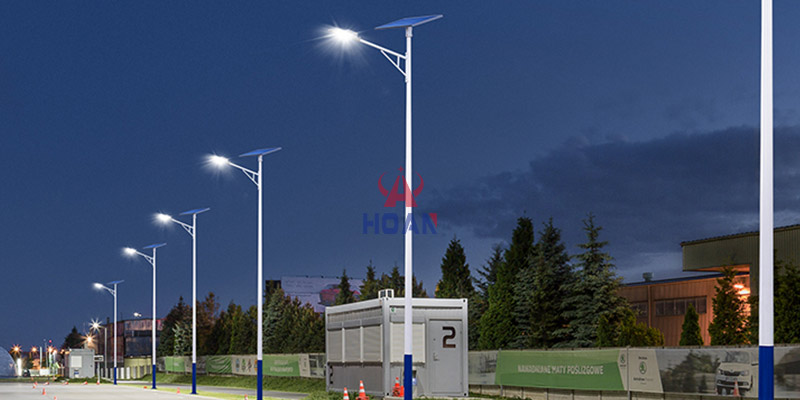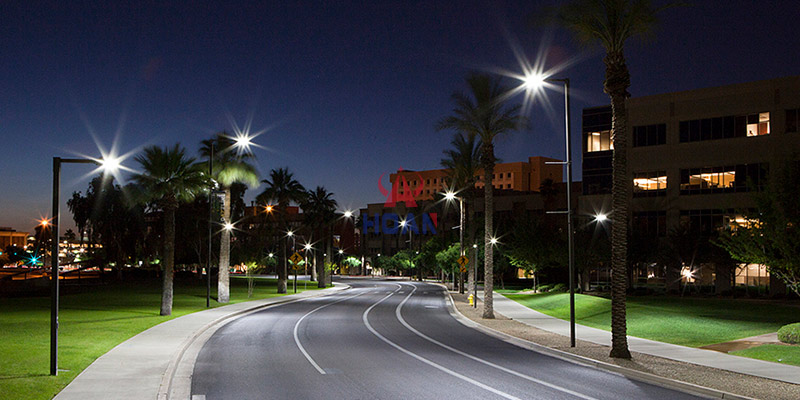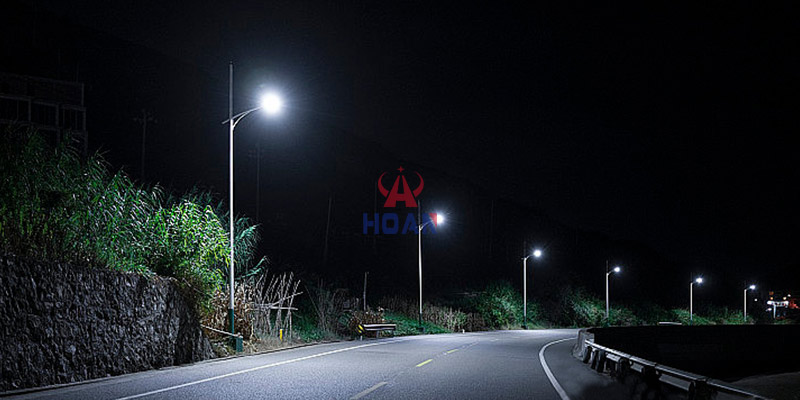In the world's strong advocacy of green energy and energy-saving lighting, solar LED street lights as a cutting-edge lighting solutions, the heat continues to climb. It plays a key role in urban construction, rural development and all kinds of outdoor lighting. In this article, we will introduce solar energy LED street light, from the definition, types, to application scenarios, comparative advantages and installation methods, to help readers understand this product, and provide a strong reference for lighting project decision-making.
Core Components
Solar LED street light is mainly composed of solar panels, LED light source, batteries, controllers and poles. The solar panel is like an ‘energy collector’, responsible for capturing the energy in the sunlight; the LED light source is the ‘luminous protagonist’, providing bright illumination; the battery is used to store electricity, guaranteeing the power supply at night or when there is insufficient light; the controller is like an ‘intelligent housekeeper’. The controller is like an ‘intelligent housekeeper’, regulating and controlling the transmission and use of electric energy; the lamp pole plays the role of supporting and fixing the various components.
Energy Conversion and Lighting Process
During the day, the solar panel is bathed in sunlight and converts solar energy into electricity through the photoelectric effect. The principle is that the semiconductor material inside the solar panel absorbs photon energy, prompting electrons to jump and generate electric current. This electrical energy is stored in a battery. At night, the battery releases the electrical energy, which is precisely regulated by the controller to drive the LED light source. The controller can reasonably control the current level according to the ambient light, time and other factors, to ensure that the LED lights work stably and efficiently, realising the whole process of lighting.
Energy Saving Characteristics
One of the biggest highlights of solar LED street light is energy saving. Solar energy is a renewable energy source, which is inexhaustible. Compared with the traditional street lamps relying on utility power supply, the energy consumption of solar LED street lamps is greatly reduced. Taking common urban street lighting as an example, traditional street lights may consume several degrees of electricity per night, while solar LED street lights can reduce energy consumption by 60% - 80% under the same lighting hours, with remarkable energy saving effect.
Interpretation of environmental attributes
From the perspective of environmental protection, solar LED street light has obvious advantages. Throughout the lighting process, it will not emit carbon dioxide, sulfur dioxide and other harmful gases, no pollution to the atmosphere. Moreover, LED light source does not contain mercury, lead and other toxic elements, avoiding the traditional lamps and lanterns after the disposal of soil and water pollution. From production to use to the final disposal, solar LED street lamps are practicing the concept of green environmental protection.

Low power street light characteristics and applications
Low power solar LED street light with power below 20W has unique application scenarios. In the park path, it sends out soft light, not only can illuminate the path of visitors, but also will not destroy the park's quiet, warm atmosphere. Community trails are also suitable for this type of street light, its energy-saving characteristics can reduce the overall energy consumption of the community, and does not produce light pollution, to protect the residents of the night travelling safety at the same time, does not affect the residents rest.
Medium-power street light applicable scenes and advantages
Medium power solar LED street light with power between 30W - 60W is widely used in rural roads and factory roads. Rural roads usually have low traffic flow and relatively low light intensity requirements, medium power solar LED street light can meet the demand with moderate brightness, while its good cost performance reduces the construction cost of rural lighting facilities. On the factory road, these street lights can provide sufficient lighting for the night operation area to ensure the smooth progress of production activities.
High-power street light performance and use of the scene
High-power solar energy LED street light with power over 80W is the main force of urban main road and large square lighting. Urban main roads have high traffic volume and fast speed, and need high brightness and wide range of lighting to ensure traffic safety. High-power solar LED street lamps can clearly illuminate road markings, road edges and the surrounding environment with their powerful lighting ability. Large squares are densely populated with people and rich activities. The strong light from high power streetlights can meet the lighting needs of night activities in the squares and enhance the safety and comfort of the squares.
Characteristics and limitations of lead-acid battery streetlights
Solar LED street light with lead-acid battery has lower cost and more mature technology. This gives it an advantage in some cost-sensitive projects, such as temporary lighting projects. However, lead-acid batteries are heavy and less convenient to install and transport. And their lifespan is relatively short, with the number of charge/discharge cycles typically around 300 - 500. In low temperature environment, the performance will also drop dramatically. Therefore, there are some limitations of lead-acid battery street lights in cold areas or long-term use projects.
Advantages of Lithium Battery Street Light and Application Expansion
Lithium battery solar LED street light shows many advantages. It has high energy density and can store more power under the same volume or weight, which means the street light has a stronger endurance. Its light weight makes installation and transport easy. It has a long lifespan and can be charged and discharged more than 1000 - 2000 times, which greatly reduces the cost of replacing batteries at a later stage. In addition, lithium batteries have good low-temperature performance and can work normally in cold areas. Therefore, in the cold areas of roads, long-distance highway and high quality requirements of high-end places, lithium battery solar LED street lamps are widely used.
Advantages of Main Road Lighting
The advantages of solar LED streetlights are obvious on the main roads in the city. High-brightness LED light source can clearly illuminate the road surface, whether it is the lane demarcation line, traffic signs, or roadside pedestrians and obstacles, can be clear at a glance, and effectively protect traffic safety. The icing on the cake is the intelligent control system, which automatically adjusts the brightness according to traffic flow and time of day. Late at night when the traffic flow is reduced, automatically reduce the brightness, saving electricity; morning and evening peak hours, increase the brightness to ensure adequate lighting.
Improvement of lighting on secondary roads and back alleys
The lighting conditions of secondary roads and back alleys were often poor in the past, and the appearance of solar LED street lights has changed this situation. The installation cost is relatively low and no complicated grid wiring is required. Through the reasonable setting of the location and number of street lights, the quality of lighting can be improved at a lower cost, providing convenience for residents travelling at night and improving the living environment. At the same time, its environmental characteristics will not cause pollution to the surrounding environment, and the community green development concept.
Rural road construction
Rural areas, especially remote villages, have insufficient power grid coverage and high wiring costs. Solar LED streetlights are free from the reliance on the power grid, making them an ideal choice for rural road lighting. It facilitates night activities in the countryside, such as villagers' travelling and transport of agricultural products, and promotes economic and cultural exchanges in the countryside. A solar-powered LED street lamp lights up the night in the countryside and brings new opportunities for rural development.
Improvement of Infrastructure in Remote Areas
In remote mountainous areas and grasslands, solar-powered LED streetlights provide reliable lighting for communication base stations, border guard posts and other infrastructure. These areas are far away from the city, power supply is difficult, solar LED street lamps with independent power supply system, to ensure the normal operation of facilities at night. For example, border guard posts can clearly observe the surrounding situation at night with the help of solar-powered LED street lights to ensure border security.
Creating a Comfortable Atmosphere
Parks are places for people's leisure and entertainment, where solar LED streetlights play a unique role. Its various shapes and soft light create a comfortable and pleasant leisure atmosphere. In the lakeside walkway, the warm yellow light and the lake reflect each other; in the forest path, the street light emits a faint light to guide the direction for people walking, while not affecting the natural growth of plants and animals, in line with the requirements of ecological and environmental protection in the park.
Scenic spot characteristic lighting to create
Scenic spots have unique natural and humanistic landscapes, and solar LED streetlights can be customised according to the scenic characteristics. In the historical and cultural scenic spots, the street light modelling can be integrated into the ancient architectural elements, and the ancient buildings complement each other; in the natural scenic area, the street light can be bionic design, and the surrounding natural environment into one. In this way, street lights not only provide lighting, but also become part of the scenic landscape, enhance the overall image of the scenic area and tourists visiting experience.

Comparison of Energy Consumption Data
In terms of energy consumption, there is a significant difference between solar LED streetlights and traditional streetlights. Take common road lighting as an example, the power of traditional high-pressure sodium lamps is generally in the range of 150W - 400W, and to achieve the same lighting effect, the power of solar LED street lamps is only 30W - 100W. assuming that the lighting is 10 hours per day, the traditional high-pressure sodium lamps consume 1.5 - 4 degrees of electricity per day, and the solar energy LED street lamps consume 0.3 - 1 degree of electricity per day, the reduction of energy consumption is as high as 60% - 87.5%, energy saving advantages are obvious at a glance. The advantages of energy saving are obvious at a glance.
Energy efficiency analysis
In the process of converting electricity into light energy, there is a large amount of energy loss in traditional street lights. For example, high-pressure sodium lamps emit light by heating sodium vapour, most of the electricity is converted into heat energy and wasted, and only a small part of it is really converted into light energy. The LED light source of solar energy LED street light, high luminous efficiency, electrical energy can be efficiently converted into light energy. At the same time, solar panels on the conversion of solar energy utilisation rate is also improving, the current conversion efficiency of high-quality solar panels can reach 20% - 25%, further improving the efficiency of energy use.
Comparison of toxic and hazardous substances
Traditional street lamps, such as fluorescent lamps containing mercury, require the use of toxic substances such as mercury during the production process, and if the lamps are damaged during use, the mercury may leak and cause pollution to the environment. After disposal, improper handling will also cause mercury to seep into the soil and water sources, endangering the ecological environment and human health. On the other hand, the LED light source of solar LED street light does not contain mercury and other toxic elements, which eliminates such pollution from the source, and the whole lighting system has no harmful gas emission, which is friendly to the environment.
Carbon Emission Comparison
According to the energy consumption data, traditional street lights rely on utility power, which produces carbon emissions. Assuming that one degree of electricity produces 0.8 - 1 kg of carbon dioxide, traditional high-pressure sodium lamps consume 1.5 - 4 degrees of electricity per day, and emit 1.2 - 4 kg of carbon emissions per day. Solar LED street lights utilise solar energy and have no carbon emissions, which plays a significant role in helping to reduce carbon emissions and combat climate change.
Lighting Coverage and Brightness Uniformity
Due to the limitation of optical design, traditional street lights are prone to dead ends and uneven brightness distribution. For example, in some curves and intersections, the light can not be fully covered, affecting traffic safety. Through reasonable optical design, such as the use of special lenses or reflectors, solar LED street lights can achieve wider and more uniform lighting coverage. In the same lighting area, solar LED street light can make the road surface brightness closer to each point, improve the overall lighting effect.
Maintenance Frequency and Cost Comparison
Traditional street light bulbs have a shorter lifespan, usually 1000 - 5000 hours, and need to be replaced frequently. Moreover, the lines are complicated and prone to failure, making maintenance difficult and costly. According to statistics, the number of maintenance times of traditional street lamps can be up to 4 - 6 times per year, and the cost of each maintenance is 300 - 500 yuan. The life span of LED light source of solar energy LED street light is up to 20,000 - 50,000 hours, and the intelligent control system can monitor the failure in real time, with low maintenance frequency, the maintenance frequency is about 1 - 2 times per year, and the cost of each maintenance is about 100 - 200 yuan, which greatly reduces the maintenance cost.

List of tools and materials
A series of tools and materials need to be prepared for the installation of solar LED street lights. As for tools, spanner is used to tighten bolts and nuts, screwdriver is used to install lamps and controllers, and drill is used to make holes for fixing. Materials include light poles, made of steel, aluminium alloy, etc., which need to be selected according to the installation environment; solar panels, LED lamps, batteries, controllers, to ensure that their specifications are matched; and bolts, nuts, wires and other connecting materials, each of which has its own specifications, such as the bolt diameter and length to meet the strength of the parts connected.
Installation site survey points
It is crucial to survey the site before installation. First of all, to determine the light conditions of the installation location, the daily sunshine duration needs to reach 6 - 8 hours or more, in order to ensure the effective charging of solar panels. At the same time to check the ground bearing capacity, to ensure that it can withstand the weight of the pole and equipment. Also check the surrounding environment, there are no trees, buildings and other obstructions affecting the solar panel lighting. For example, if the solar panel is installed beside a road with tall trees, the branches should be trimmed or the installation position should be adjusted in advance.
Light pole installation process
Pole installation starts with digging a pit, which is generally 0.8 - 1.2 metres deep and 0.3 - 0.5 metres in diameter, depending on the height and weight of the pole. When pouring the concrete foundation, the concrete ratio is generally cement: sand: stone = 1:2:3. Place the light pole into the pit, adjust the verticality, and then fix it with bolts. When the bolts are tightened, they should be tightened in diagonal order, and the torque should be controlled within the specified range to ensure that the light poles are firmly installed.
Installation of solar panels and lamps
Install the solar panel on the top of the light pole and adjust the angle to get the best lighting effect. The angle can be calculated according to the local latitude, generally between 30° - 60°. Use the special bracket to fix the solar panel, make sure it is firmly installed. install the LED lamps on the appropriate position of the pole, adjust the irradiation direction so that it can effectively illuminate the target area, fix the lamps to prevent shaking.
Battery and controller connection
When connecting the battery to the controller, make sure the positive and negative poles are connected correctly. Place the battery in a dry, ventilated location and avoid direct sunlight. The controller is installed in a place where it is easy to debug and maintain, such as the control box in the lower part of the pole, and it should be well protected from moisture and sunlight. After the connection is completed, check the status of the controller indicator to ensure that the connection is normal.
Function debugging method
Functional debugging after the installation is completed. Block the solar panel with a light shield to simulate the night environment, and observe whether the LED lights are on normally. Adjust the controller settings and test the working status of the street light in different modes, such as light control mode, time control mode, human body sensor mode, etc., to ensure that the street light functions normally.
Safety and stability check
The safety and stability check of the street light after installation should not be neglected. Check whether the pole is vertical or not, you can use a level to measure. Check whether the parts are firmly connected, such as solar panels, lamps and lanterns, and whether the fixed bolts of the controller are loose. Gently shake the street light to check the overall stability, to ensure the quality of street light installation and safety.